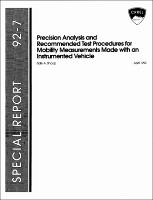Please use this identifier to cite or link to this item:
https://hdl.handle.net/11681/12267Full metadata record
| DC Field | Value | Language |
|---|---|---|
| dc.contributor.author | Shoop, Sally A. (Sally Annette) | - |
| dc.date.accessioned | 2016-06-20T14:31:34Z | - |
| dc.date.available | 2016-06-20T14:31:34Z | - |
| dc.date.issued | 1992-04 | - |
| dc.identifier.uri | http://hdl.handle.net/11681/12267 | - |
| dc.description | Special Report | - |
| dc.description | Abstract: This report addresses the precision of mobility measurements made using an instrumented vehicle. Systematic errors were documented and new techniques established to eliminate or minimize these errors. An increase in the precision and accuracy of mobility measurements will allowthe successful pursuit of new research efforts of concern to cold regions mobility, such as the resistance measurements of trailing tires and terrain resistance on shallow snow or winter soils. Systematic errors due to calibration methods, temperature, vehicle speed and weight distribution were observed and quantified. Based on these results, suggested techniques to eliminate or minimize these errors and improve precision areas follows. 1) The method of calibration (air, static or rolling) should be chosen based on the objective of the experiment. Calibrating the vehicle while it is rolling yields the most consistent results from test to test; however, a static calibration is needed to measure the total resistance of the vehicle running gear. 2) Because of the wide range of temperatures considered in cold regions testing and the temperature sensitivity of the equipment, the vehicle and all equipment should be operating and temperatures stabilized before vehicle calibration and testing begins. If theweather changes significantly during the course of the tests, it should be noted and the vehicle should be recalibrated. 3) The vehicle must be on as level and smooth a surface as possible because the load on the wheels is extremely sensitive to weight distribution (and tilt) of the vehicle. Small variations in the weight distribution are also reflected in the contact area of the tires. 4) Mobility testing procedures should routinely include a hard surface motion resistance measurement for each set of test conditions to serve as a reference for the terrain mobility measurements and as a comparison between data sets. | - |
| dc.publisher | Cold Regions Research and Engineering Laboratory (U.S.) | - |
| dc.publisher | Engineer Research and Development Center (U.S.) | - |
| dc.relation | http://acwc.sdp.sirsi.net/client/en_US/search/asset/1024982 | - |
| dc.rights | Approved for public release; distribution is unlimited. | - |
| dc.source | This Digital Resource was created from scans of the Print Resource | - |
| dc.subject | Experimental error | - |
| dc.subject | Statistical analysis | - |
| dc.subject | Vehicle mobility | - |
| dc.subject | Trafficability | - |
| dc.subject | Traction | - |
| dc.subject | Tires | - |
| dc.subject | Vehicles | - |
| dc.title | Precision analysis and recommended test procedures for mobility measurements made with an instrumented vehicle | - |
| dc.type | Report | en_US |
| Appears in Collections: | Special Report | |
Files in This Item:
| File | Description | Size | Format | |
|---|---|---|---|---|
| SR-92-7.pdf | 2.45 MB | Adobe PDF |  View/Open |